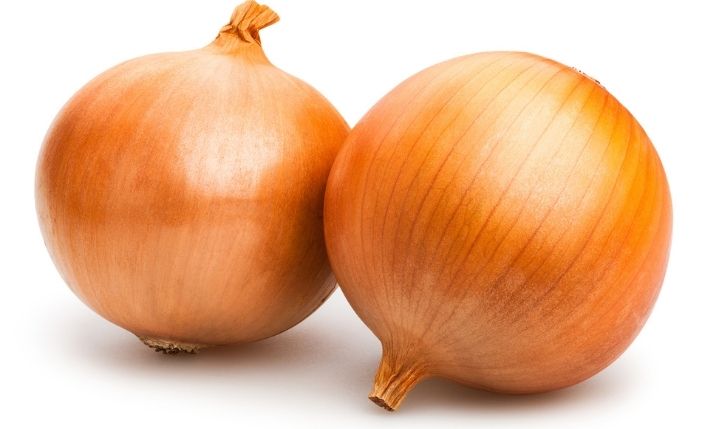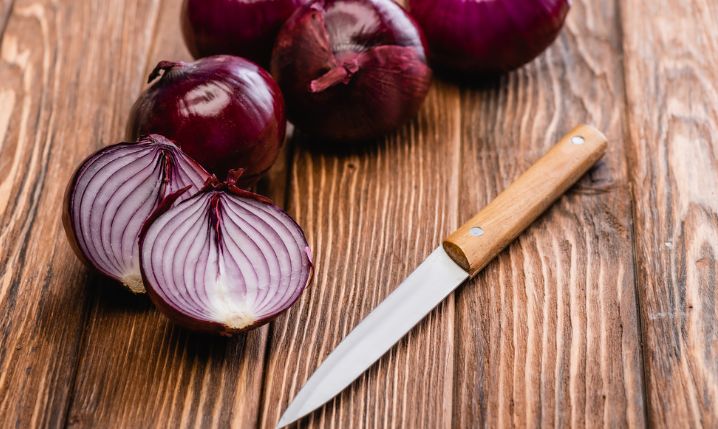There are many types and varieties of onions, some of which can look similar, others not. However, it’s common to want to learn more about them and their differences, so you know how to use them in your next dish. This article will teach you all you need to know when comparing Spanish onions vs. red onions.
Contents:
What Are Spanish Onions?

Spanish onions are a type of yellow onion which taste both mild and sweet. Therefore, they’re also considered a type of sweet onion. They are medium-large in size with brown or “yellow” skins.
Unlike many onions, the Spanish onion is considered to have a mild taste and, despite being a sweet onion, isn’t as sweet as many other sweet onion varieties.
Owing to being grown in shallow soil, these onions have a high water content giving them a crunchy texture that makes them ideal for salads and other dishes where you would want to use raw onions.
You can use them for salads, relishes, salsas, garnishes, and even as toppings for pizzas and other foods you can cook under a grill.
What Are Red Onions?

Red onions are a type of medium-large onion with purple-red skins and a reddish and white inner flesh. They are most often used in cooking as they have both a strong and sharp taste.
There are several types of red onions as they are now cultivated worldwide but were believed to originate in Asia. Some varieties of red onion are more pungent than others, while some can be milder and sweeter.
While the red onion is most often used for cooking, you can also use them raw for salads. It is often recommended to cut red onions and soak them in water for 10-20 minutes to reduce the sharp pungent flavor if you want to use them raw.
When cooked, red onions release natural sugars and become sweeter, which makes them popular when fried and added to hot dogs, burgers, and more.
This makes red onions an incredibly versatile onion for both cooked and raw dishes, depending on how you use them.
What’s The Difference Between Spanish Onions and Red Onions?
| Spanish Onion | Red Onion |
|---|---|
| A type of yellow onion. | A variety of onions. |
| Best for salads, garnishes, relishes, pizzas, and similar. | Best for cooking but can be used raw when soaked in water to reduce sharpness. |
| Tastes mild to sweet. | Tastes sharp and strong to mild and sweet. |
| Medium to large in size with brown skins. | Medium to large in size with purplish-red skins. |
The most obvious difference between Spanish onions and red onions is their appearance. Spanish onions have yellow/brown skins, while red onions have purple-red skin. The inner flesh of a Spanish onion looks like most onions, yellow-white, whereas red onions have a reddish flesh intermixed with larger white sections between layers.
They’re available in similar sizes, which makes them useful as direct substitutes for one another in the right situations. However, red onions are known to contain properties that allow them to last much longer when stored in the right conditions.
You can use them both in similar dishes, but the flavor can differ because Spanish onions always taste mild to sweet, while the red onion is most often sharp and strong but can be milder in some varieties. Additionally, red onions become sweeter when cooked. In contrast, Spanish onions aren’t recommended for most cooking uses because of the high water content, which can leave them slimy and bland tasting when cooked.
All of this means that red onions are more versatile since you can use them in most cooked dishes or raw dishes when you soak them to reduce the pungency and strong flavor. However, red onions aren’t the most suitable for slow-cooking, whereas the Spanish onion makes a suitable option for stews and soups, etc.
- Size: Both of these onions are medium-large in size.
- Appearance: Since the Spanish and red onion share a similar size and round-bulbous shape, they’re noticeably different because of their colors. Spanish onions are yellow/brown, and red onions are purple/red.
- Taste and texture: Both onions have a crunchiness when consumed raw, which you won’t find with all onions. However, the Spanish onion has slightly more crunch than the red. Red onions are stronger, sharper, and more pungent than Spanish onions, which means they’re not perfect for raw dishes unless cut and soaked. The Spanish onion is better when consumed raw because of its mild and sweet flavor.
- Culinary uses: You can use both in most situations, but Spanish onions are often used for toppings, salads, and similar. Red onions are more often used for frying and grilling. You can also use red onions raw in salads, but they can be pungent when not prepared correctly. While the Spanish onion can work well for slow cooking, it is not always recommended to use red onions in those types of recipes.
Conclusion
You now know all you need to know when comparing the Spanish onion vs. red onion. In some situations, you can use them as a substitute for one another, but there are some important differences too. Thankfully, the red onion is versatile enough to make them a great option in most dishes, but you should be more careful with them when slow-cooking or using raw, especially when compared to the Spanish onion.